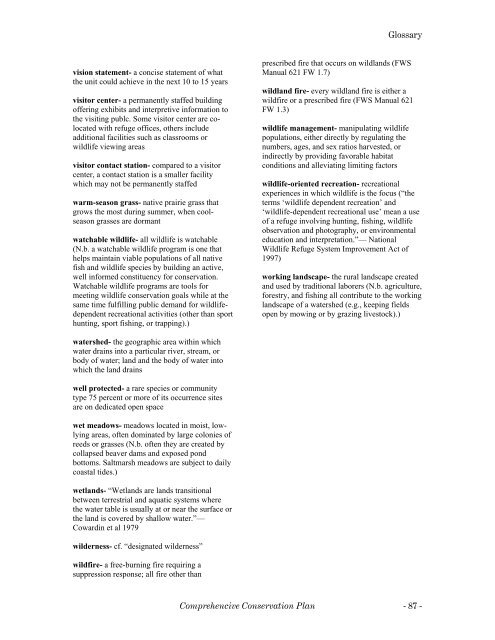Assabet River NWR Final CCP - U.S. Fish and Wildlife Service
Assabet River NWR Final CCP - U.S. Fish and Wildlife Service
Assabet River NWR Final CCP - U.S. Fish and Wildlife Service
You also want an ePaper? Increase the reach of your titles
YUMPU automatically turns print PDFs into web optimized ePapers that Google loves.
vision statement- a concise statement of what<br />
the unit could achieve in the next 10 to 15 years<br />
visitor center- a permanently staffed building<br />
offering exhibits <strong>and</strong> interpretive information to<br />
the visiting publc. Some visitor center are colocated<br />
with refuge offices, others include<br />
additional facilities such as classrooms or<br />
wildlife viewing areas<br />
visitor contact station- compared to a visitor<br />
center, a contact station is a smaller facility<br />
which may not be permanently staffed<br />
warm-season grass- native prairie grass that<br />
grows the most during summer, when coolseason<br />
grasses are dormant<br />
watchable wildlife- all wildlife is watchable<br />
(N.b. a watchable wildlife program is one that<br />
helps maintain viable populations of all native<br />
fish <strong>and</strong> wildlife species by building an active,<br />
well informed constituency for conservation.<br />
Watchable wildlife programs are tools for<br />
meeting wildlife conservation goals while at the<br />
same time fulfilling public dem<strong>and</strong> for wildlifedependent<br />
recreational activities (other than sport<br />
hunting, sport fishing, or trapping).)<br />
watershed- the geographic area within which<br />
water drains into a particular river, stream, or<br />
body of water; l<strong>and</strong> <strong>and</strong> the body of water into<br />
which the l<strong>and</strong> drains<br />
well protected- a rare species or community<br />
type 75 percent or more of its occurrence sites<br />
are on dedicated open space<br />
wet meadows- meadows located in moist, lowlying<br />
areas, often dominated by large colonies of<br />
reeds or grasses (N.b. often they are created by<br />
collapsed beaver dams <strong>and</strong> exposed pond<br />
bottoms. Saltmarsh meadows are subject to daily<br />
coastal tides.)<br />
wetl<strong>and</strong>s- “Wetl<strong>and</strong>s are l<strong>and</strong>s transitional<br />
between terrestrial <strong>and</strong> aquatic systems where<br />
the water table is usually at or near the surface or<br />
the l<strong>and</strong> is covered by shallow water.”—<br />
Cowardin et al 1979<br />
wilderness- cf. “designated wilderness”<br />
wildfire- a free-burning fire requiring a<br />
suppression response; all fire other than<br />
Glossary<br />
prescribed fire that occurs on wildl<strong>and</strong>s (FWS<br />
Manual 621 FW 1.7)<br />
wildl<strong>and</strong> fire- every wildl<strong>and</strong> fire is either a<br />
wildfire or a prescribed fire (FWS Manual 621<br />
FW 1.3)<br />
wildlife management- manipulating wildlife<br />
populations, either directly by regulating the<br />
numbers, ages, <strong>and</strong> sex ratios harvested, or<br />
indirectly by providing favorable habitat<br />
conditions <strong>and</strong> alleviating limiting factors<br />
wildlife-oriented recreation- recreational<br />
experiences in which wildlife is the focus (“the<br />
terms ‘wildlife dependent recreation’ <strong>and</strong><br />
‘wildlife-dependent recreational use’ mean a use<br />
of a refuge involving hunting, fishing, wildlife<br />
observation <strong>and</strong> photography, or environmental<br />
education <strong>and</strong> interpretation.”— National<br />
<strong>Wildlife</strong> Refuge System Improvement Act of<br />
1997)<br />
working l<strong>and</strong>scape- the rural l<strong>and</strong>scape created<br />
<strong>and</strong> used by traditional laborers (N.b. agriculture,<br />
forestry, <strong>and</strong> fishing all contribute to the working<br />
l<strong>and</strong>scape of a watershed (e.g., keeping fields<br />
open by mowing or by grazing livestock).)<br />
Comprehencive Conservation Plan - 87 -

















